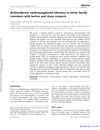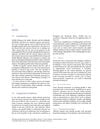Zoonotic Potential of Dermatophytosis in Small Mammals
July 2015
in “
Journal of exotic pet medicine
”
TLDR Humans, especially vulnerable groups, can catch skin infections from small mammals.
The document discussed the zoonotic potential of dermatophytosis in small mammals, highlighting that various keratin-digesting fungi, particularly Trichophyton mentagrophytes, are common culprits. Dermatophytosis can be transmitted from animals to humans, often through direct contact or contaminated materials. Clinical signs in small mammals vary by species and disease stage, and young animals are particularly vulnerable. Diagnosis involves physical exams and various tests, while treatment includes topical antifungals. The condition is most prevalent in rabbits and guinea pigs, with emerging cases in hedgehogs.




